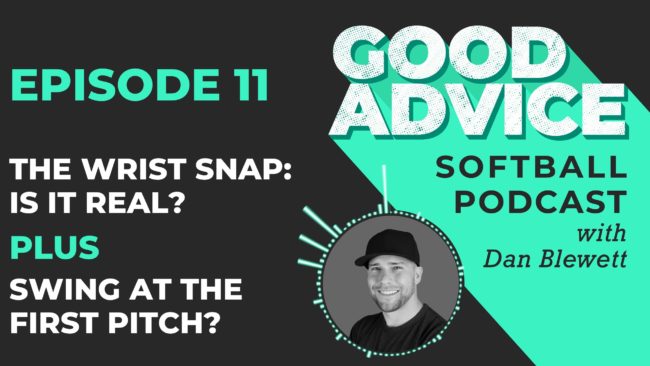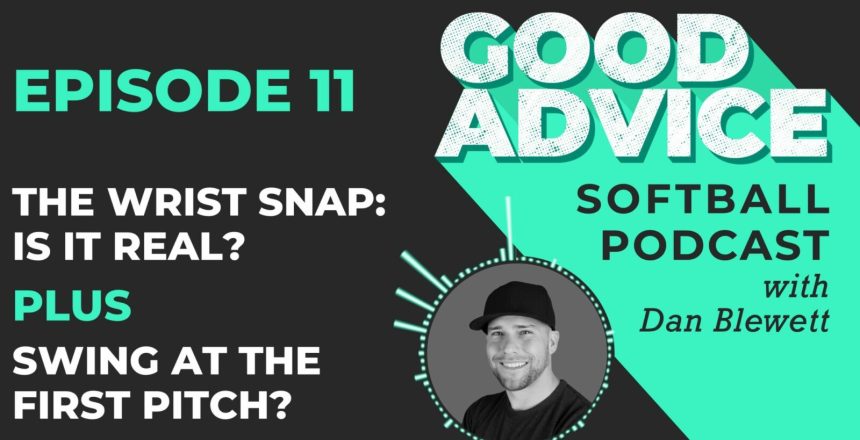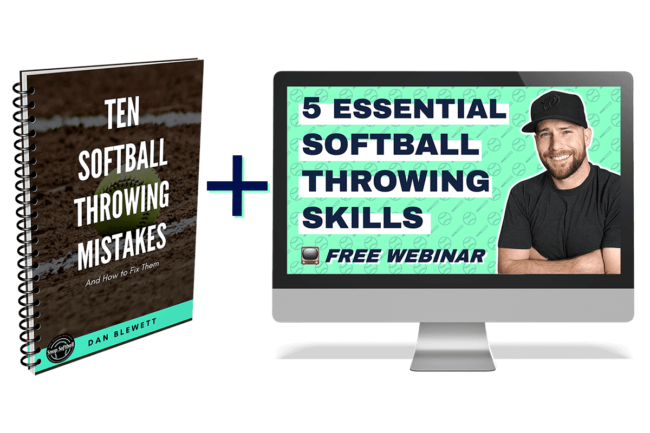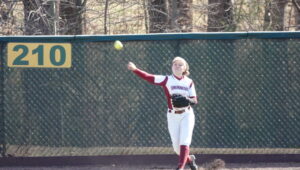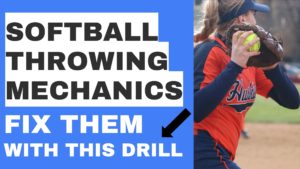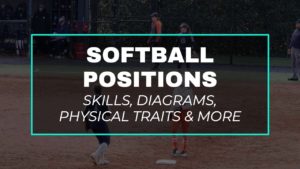*This article may contain product links which pay me a small commission if you make a purchase. Learn more.
Is the wrist snap in softball throwing actually important? Should players be encouraged to swing early in the count, or at the first pitch? And, what standards should a 16U player be held to in the weight room? For more on the wrist snap, watch my recent YouTube video with slow-mo examples of the wrist snap.
To submit a question for the Good Questions Q&A segment, make a voice recording and email it to Dan at hello@danblewett.com. Want to support the show? Enroll in one of Coach Dan’s online throwing courses or his mental skills course. Use code GOODADVICE to save 20% on any course, just for being a listener. Sign up for Dan’s Email list and get his free throwing eBook, and follow up with him on the interwebs: YouTube Channel | Twitter | Snapsoftball.com
Podcast: Play in new window | Download
Subscribe: Apple Podcasts | Spotify
Transcript: EP11 – Should You Swing at the First Pitch? Strength Training Milestones & The Wrist Snap in Throwing
You are listening to the good advice, softball podcast. I’m Dan Blewett. And on this show, you’ll learn how to help the softball player in your life. Sharpen her skills, improve her mindset and find new confidence through softball.
Hey, welcome back to the good advice softball podcast. I’m Dan Blewett in today’s episode, we’re going to cover three topics. Number one, should you swing early in the count? Should he swing late in the count? Should, uh, should a player try to see as many pitches as they can in a bat? And should you swing.
Three and O so we’ll talk about some hitting strategy. First second, we’ll talk about some strength training milestones. So these are ones that I would say that as a 16 year old who’s, you know, on the college recruiting trail, these are some strength, milestones that you’d want to meet on key exercises in the weight room.
And lastly, a question that I’ve gotten recently on YouTube was. How do we improve our risk snap on our throws? So I’m going to talk about that briefly and kind of debunk a little bit about, um, the risk snap. All right. So first thing, should you swing early in the count? Should you swing later in the count?
Should you try to see a lot of pitches? So all of these are actually no Mars, and I think all of these are confusing to hitters. And the reason being is there’s never a bigger task other than trying to pick out the pitch that you want to hit and then drive it. So when I was still coaching, our big thing was you need to aid, understand who you are as a hitter and what pitch you can dry.
Like what pitched you had. Well, is it pitch? Is it something right down the middle? Is it something maybe like middle end? Is it something a little bit elevated, like belt? Hi, do you like the ball low? Like if you were in a home run Derby a what and you could program a robot to throw it exactly where you wanted it.
Where would you put it? So that’s a question that a lot of hitters don’t actually have a good answer to, and they’d need to just do some soul searching and think about, you know, what their approaches at the plate, you know, for some players, they might be out or half because they’re really good at driving the ball the other way.
And they like to see the ball deep, uh, you know, it’s, it’s different for every player. So number one is understanding what is your pitch? And then once you know, what your pitch is, the question is, can I get it and can I identify it out of the pitcher’s hand? And when I get that pitch and that location.
Then what am I going to do with it? And how do I prevent missing it? So obviously the goal of pitching being good pitcher is to disrupt hitter’s timing and to get them to put the ball in play without hitting it very hard. That’s how you get lots of outs. And if that’s sort of your mindset as a pitcher, then you’re going to be successful.
You’ll get swings and misses. You’ll get strikeouts, but you’ll also just have a good pitch efficiency and kind of cruise through games. So when a pitcher makes a hitter or. Induces a hitter to swing at a pitch on the attic or the plate or the inner third of the plate. Those are locations where it’s tough to barrel the ball up and hit it hard.
So essentially the pitcher wins anytime, a hitter swings at a pitch that’s on the peripheral of the, of the plate of the strike zone. So if it’s on the corners, It was at the top board of the strike zone, the very bottom border. Those are typically places where the pitcher wins much more so in and out. So outside corner inside corner.
Um, and so given that the hitters trying to not swing at those pitches, so it’s not a matter of just taking strikes or not taking strikes as a matter of taking pitches that you can’t drive well. And the ones that are on the. Maybe on the plate that are strikes that you really know that you probably can’t put a good swing on you probably can’t hit in the gaps, stuff like that.
Yeah. So the highest level players aren’t just taking balls, they don’t just have good play discipline where they don’t swing at balls, but they’re also not swing at unhittable strikes or difficult to hit strikes. That’s the other thing that really good hitters do. So they only tend to swing at pitches that are pretty center cut.
In the middle of the plate and in their own wheelhouse. So you can’t always only swing at pitches that are your exact pitch, like middle end, fast ball, whatever. Uh, but you can put good swings on half fast balls or, you know, drop ball, like down in the middle of the plate, something like that. So just because it’s not your one specific happy location, you can still get pitches that are pretty center cut in the middle of the plate.
You can hit hard. So when we start talking about overall philosophy about, should you swing early in the count and try to, you know, jump on the pitcher early? Um, you know, even if a pitcher has a strategy of throwing, you know, more straight stuff early in the bat, that’s fine, but you’re still not gonna swing at a early fast ball.
It was on the outer corner of the plate. Like that’s not a good strategy. So gearing yourself up to be ready to hit in any count is important. But a lot of times young players don’t understand that. And when they get the mindset of, Oh, coach says, I need a swing early in the count. So I’m going to get ready and ends and pretty, you know, I’m going to almost make up my mind to swing at a pitch.
On the first or second pitch. And when they sort of predetermined what they’re going to do, like I’m ready to hit this pitch. Then they end up swinging. It’s only, they don’t really, we want to hit, they start to over commit. Oh, there’s a one what I wanted. And then I swung at it and Oh, outer third. That was kind of tough.
And I ground up to short. So, but when the mindset is hit your pitch, no matter when it comes in the bat, that’s a little more freeing, which means, Hey, if they throw a pitch that you want to drive, that you believe you can hit hard on the first pitch, then swing on the first pitch and hit and give it a, give it a ride, hit it hard.
Or if it’s you’re fighting pitches off. And I didn’t like that. And when I didn’t like that one, that one’s a ball that one’s a ball. I found that one off and now you see six pitches and then you get one to drive. That’s fine too. Really? You’re just sort of like searching for buried treasure. Sometimes you might get lucky and on the first dig, you find something, sometimes it might take 95 shovel fulls before you find anything.
And that’s kind of how hitting is. It’s always random. So you don’t want to be guessing. And assuming you’re going to swing at the first pitch just to jump on the pitcher. Like there is no advantage to jumping on the pitcher, but sometimes pitchers fall into patterns where they throw their nastiest stuff later in the bat.
And so they give you a better chance at, you know, they want to get ahead and they throw easier to hit stuff early in the count, because they’re just trying to use more margin for error and throw stuff. They can reliably get strikes with early in the count. So a lot of times it does make sense to be aware that Hey, You’re more likely to get a straight pitch earlier in the bat.
And you’re more likely to get lots of breaking balls later than the at bat. So make sure you’re not snoozing and make sure you’re not being too passive early on and be aware that you’ll probably get more straight stuff early in the bat. Well, that’s a fast ball or change. So with all that being said, there is no one.
Mindset about what to do except high level hitters. They don’t swing at balls. They don’t swing at borderline pitches unless they have to foul them off. But they’re never, their intent is almost never to put the ball in play when they swing at a borderline pitch. Cause it’s not easy to hit pitch. Their goal is to foul stuff off to take stuff they can’t drive until they get a pitch that they can drive.
They can hit very hard. So the idea of swinging early or late. Is again, it’s a misnomer. I think as if you’re a coach listening or parent, this is important to communicate with your daughter and saying that, Hey, we’re not just trying to get you to, so there’s no advantage of that. Getting to hitting the ball on the second pitch, but this pitcher is throwing a lot of stuff that looks easier to hit on the first and second and third pitch.
So. Be mentally ready to swing at something, even if it’s not yours, if it’s pretty darn good. That’s okay. But you have to be clear about it. And then just the blanket statement of, Hey, see a lot of pitches. We need to see more pitches. Well, are you taking pitches that you could drive? Cause that’s not good either.
Like there’s no advantage to hitting the fifth pitches yet of the bat. If it’s a tough to hit pitch and you took two good ones early on. Either. Right. Like we know that too. So the long story short here is the best hitters in the world. Take balls. They take borderline pitches that they can’t drive. They fell off borderline pitches of they can’t drive until they get the pitch that they can drive.
And then they don’t miss it. As much as the lesser hitters, they get it a higher percentage of the time. That’s what makes them good hitters.
All right. And today’s 92nd mindset. Let’s cover some strength, milestones at age 16. Now these are going to be a little bit general, but, and obviously body weight changes from one player to the other player, but using, um, Metrics that are an expression of body. Weight is the best sort of like fairest way to do things.
So if you weigh 300 pounds, you’re expected to, you know, a 300 pound squat is less impressive than if you’re a hundred pounds and you get squat 300 pounds. Right? So as a percentage of body weight, those are the milestones that are, I’m going to give. So. If you’re not doing a lot of strength training right now, I have the encourage you to, I think it’s a very impactful thing that you can do both mentally and physically.
Um, and when you finally get there, hopefully you have a good strength coach who teaches you all these exercises and gives you fundamentals and foundation of good strength training that’s safe and effective. And so the five exercises I have chosen here were ones that we always did in my Academy. The front squat pushup, chin up trap bar dead lift, which is a hex bar, not a straight bar deadlift and the barbell hip thrust.
So those are ones that were pretty core to all of our softball players. Big lists overall, very strong. Yeah. Add good muscle, all that stuff. So for the front squat, if anything, and these are all met milestones Friday, age 16. So if you’re a sophomore in high school, these are good metrics to aspire to the front squat.
I’d say body weight on the bar. For five reps. So that means if you weigh 140 pounds, you can front squat, 140 pounds for five reps. That’s a pretty good, pretty strong female athlete for again, like 16 years old pushups, you should be at least do. A set of 15 reps, which means you can probably do three sets of 10, three sets of 12, and that’s again, sort of a minimum.
So you might be to do a lot more than that. But a lot of girls came into our Academy, could, couldn’t do one pushup. And so we eventually built them up where they could do some pushups on the ground. And then the goal is to do multiple sets of again, like 10 to 15 reps. So if you can do one set of pushups at 15 or one set of 15 pushups, you’re doing pretty well.
Chin up. The milestone, it’s hard to give like a more complex milestone, but I think if you can just do one full hang, good chin up on assisted. So no bands, nothing like that. Um, then you’re pretty strong for a female athlete. So that’s again an ASP aspirational goal. And it’s more rare than you think, because as, um, body weight goes up, upper body strength still tends to lag behind in female athletes.
So even if you have a really well built girl, who’s strong. Um, if she weighs, you know, 160 pounds, it’s still going to be tough for her to do a chin up. Cause again, with, with men, whereas as is true with men as well, you know, if your body weights pretty high, it’s tough to pull your entire body, weight up a bar and do a good chin-up.
So chin ups, if you can do one clean one at age 16, you’re in good shape. Trap bar dead lifts. Again, this is a hexagon shaped bar. Uh, they have these at most commercial gyms and almost every sports performance facility. It’s a safer version of than the straight bar dead lift. Of course, a lot less technique.
It’s also a little more quad dominant, a little less hip and back dominant. So I think it’s a better version for young athletes. Um, body weight, times 1.5 for three reps. So that means if you weigh a hundred pounds, you can do 150 pounds on the trap bar machine or not machine on the trap bar for three reps.
And when I said a body weight on. The bar for front squats earlier, that was also, if you weigh 140 pounds, it’s 140 pounds on the bar. That means the barbell, which weighs 45 pounds plus an additional 95 pounds added. So here the trap bar, you know, the weight of the bar itself, plus plates to get to one half times your body weight.
And lastly, for the barbell hip thrust two times, your body weight for six plus reps, I think is a good metric. Most of our girls could do that after two, three years of training, um, And the barbell hip thrust. If you’re not familiar, I’ll put links below in the description. Uh, but it’s a great exercise for the glutes and hamstrings, which are some of the prime movers and how fast you sprint.
So those are five, very good, um, milestones for foundational strength for a 16 year old. Female athlete, who is pretty serious about sports. Now, if you can’t do that, doesn’t mean you’re not a good softball player, but I think those are things everyone should aspire to. And if you can get to those numbers, if you’re not there yet, it’s definitely gonna improve your game by adding more power, more strength, more explosiveness, more speed to your game.
Alright, it’s time for good questions. Our listener Q and a segment. Remember if you have a question you’d like answered on the show, please email a voice recording to hello@danblewett.com. This is easy to do on your phone through the voice memos app on iPhones or any voice recorder app on Android links to email me are in the show notes.
Last question, how do I improve my wrist snap? So I keep getting this question over and over on YouTube. And again, there’s just this misnomer. It happens a little less in baseball. It happens a lot in softball that everyone thinks that there’s a snap. That occurs when you throw and there just isn’t. If you look at high speed video footage of major league baseball, pitchers, and again, I know they’re men, I know they’re playing a different, slightly different sport.
Um, but throwing is throwing. There really isn’t a snap of the wrist that arm, as it’s delivered, the risks has held a pretty steady position. The fingers are held in a relatively steady position. There isn’t all this like loosey goosey motion going on. Like the way you’d like, I don’t know. I can’t hear, I think of a good, like the way you crack a towel, right?
If you’re like in your hotel room and you’re like snap a towel, or you snap a whip. That’s not really the way your wrist works. Your wrist lines up with your, with your forearm as you start to accelerate your arm. And that’s a really, it’s the fastest human movement is your external to internal rotation of your shoulder.
So as your arm is rotating that fat, um, video. Proves this your wrist is not actively moving forward or backward as your arm accelerates. Sure. Your fingers contribute in your risks attributes, cause it’s attached to your arm. Like it has to be part of it, but there is not this like back and forth snapping motion when you throw a ball, it just isn’t that way.
Now when you throw slower, like if you just tossing, you know, across your living room, You know, throwing it 20 miles per hour, just flipping it. Sure. You can go back and forth with your wrist and you’ll feel like this, you know, smooth, snappy, whatever you want to call it motion. But if you’re actually throwing a ball hard using your whole body, your wrist does not act the same way.
It does not behave the same way. And again, I encourage you just to flip on a major league baseball game, jump on YouTube, jump on my YouTube channel and there’s videos of girls throwing in slow motion. It doesn’t happen. It just doesn’t happen. So if we keep talking about risk snap, as if it’s something we need to teach something, yeah.
You need to think about, or the reason why you’re not throwing as hard as you like to. If you’re a player, we just need to cross it off the list. It’s not part of the thing. It’s not, it’s why we don’t need the wrist. Snap drills. We warm up. It. Isn’t a thing. That’s the big thing that I want to. We’ll convey here, because again, when the arm is accelerating extremely fast, the risk stays in a relatively constant position all the way through the throw.
And there’s a little bit of oomph by the fingers of the end, but it’s, it’s not anywhere near a snap. It’s just, the arm is delivered. And the F the power is transferred from the lower body, through the core to the arm, to the elbow, to the forearm, to the wrist of the fingers, and then to the ball. So that’s how it all works.
So I’d like to leave that in the past that there is really, isn’t a risk snap in growing well, that’s all the good advice I’ve got for today. If you enjoy the show and would like to support me while also helping yourself. Enroll today in one of my online softball courses, my she’s got a cannon throwing courses, come with pricing plans for any budget.
And my resolute athlete, mental skills course will help your daughter or team build the mindset of a champion enroll in any of my courses through the links in the show notes and save 20% with code good advice just for being a listener. Be sure to subscribe to my weekly email list where you’ll get updates on all my new videos, an episode’s nearly 4,000 people get my emails and you should too sign up for the link in the show notes.
Lastly, who do you know, who can use some good advice? Please share this podcast with a friend, subscribe on iTunes, Spotify, or wherever you listen to podcasts and subscribe to my snap softball, YouTube channel, where you’ll find this podcast and hundreds of softball, instructional videos. Back when I was a player, I was always thankful for good coaches and good advice.
I’m Dan Blewett and I’ll see you next time. .

